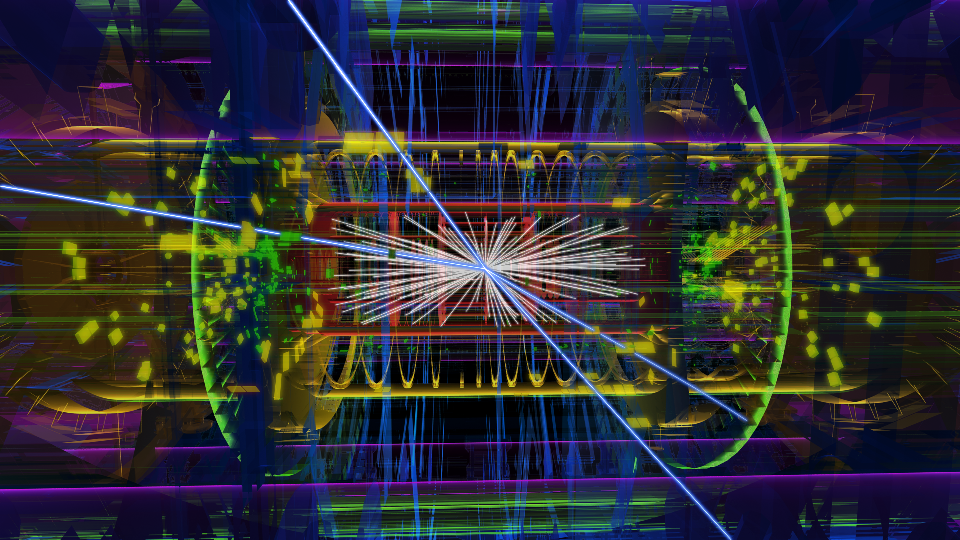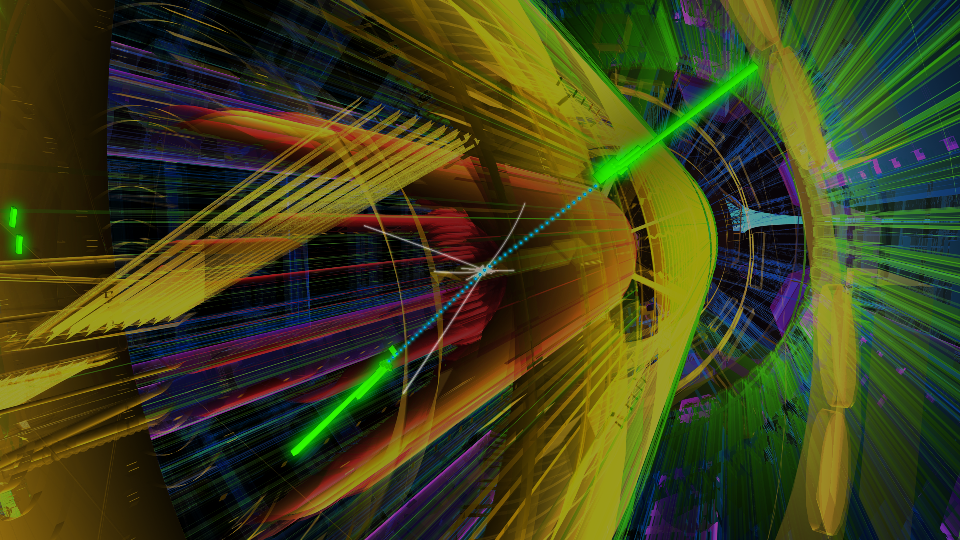Canadians Involved in the Experiment Are Excited and Eager to Press Forward
In a seminar held at CERN this morning and then repeated across Canada at multiple partnering institutions, the ATLAS and CMS experiments presented the status of their searches for the Standard Model Higgs boson. Finding this particle would snap in the last missing puzzle piece of the Standard Model that describes the universe at its most basic level. Tantalizing hints have been seen by both experiments in the same mass region, but these are not yet strong enough to claim a discovery. The main conclusion is that the Standard Model Higgs boson, if it exists, is most likely to have a mass in the range 115-130 GeV, excluding essentially all other hiding places.
"We are at a crossroads in our understanding of how energy gained mass and became matter in the early universe," said Rob McPherson, spokesperson of the Canadian team working on the ATLAS project and a professor at the University of Victoria and a research scientist with the Institute of Particle Physics. "If these hints lead to a firm discovery over the coming year, we will be at the start of our investigation of the interactions that lie behind our current theories. If they are not confirmed, we will have to reject our present understanding, throw out our current theories, and start over. It is an extremely interesting time in particle physics."
Higgs bosons, if they exist, are very short lived and can decay in many different ways. Discovery relies on observing the particles they decay into rather than the Higgs itself. Both ATLAS and CMS have analyzed several decay channels, and the experiments see small excesses in the low mass region that has not yet been excluded. In a sense, physicists have now surrounded the last remaining location where the Higgs could be hiding.
Taken individually, none of these excesses is any more statistically significant than rolling a die and coming up with two sixes in a row. What is interesting is that there are multiple independent measurements pointing to the region of 124 to 126 GeV. It's far too early to say whether ATLAS and CMS have discovered the Higgs boson, but these updated results are generating a lot of interest in the particle-physics community.
"There will be no early holiday present for particle physicists," said Nigel S. Lockyer, director of the TRIUMF laboratory that has had a key role in driving Canadian involvement in this global project. "We don't have the Higgs in our hands yet, but we're closing in. We will have a lot to confirm and then celebrate in the next year."
TRIUMF has a strong team involved in the ATLAS experiment including scientists Isabel Trigger, Reda Tafirout, Oliver Stelzer-Chilton, and Anadi Canepa at TRIUMF along with Mike Vetterli (joint with SFU), Pierre Savard (joint with Toronto), and Gerald Oakham (joint with Carleton). Rob McPherson, at UVic, is local to TRIUMF and spends much of his time at the lab. Together with Simon Fraser University, TRIUMF hosts the ATLAS Canada Tier-1 Data Centre, one of tenl large computing and data-storage farms around the world that make the CERN data available to the global collaboration of thousands of scientists. TRIUMF's Tier-1 has the world record for reliability and uptime.
"We have restricted the most likely mass region for the Higgs boson to 116-130 GeV, and over the last few weeks we have started to see an intriguing excess of events in the mass range around 125 GeV," explained ATLAS experiment spokesperson Fabiola Gianotti. "This excess may be due to a fluctuation, but it could also be something more interesting. We cannot conclude anything at this stage. We need more study and more data. Given the outstanding performance of the LHC this year, we will not need to wait long for enough data and can look forward to resolving this puzzle in 2012."
CMS experiment Spokesperson, Guido Tonelli, explained "The excess is most compatible with a Standard Model Higgs in the vicinity of 124 GeV and below but the statistical significance is not large enough to say anything conclusive. As of today what we see is consistent either with a background fluctuation or with the presence of the boson. Refined analyses and additional data delivered in 2012 by this magnificent machine will definitely give an answer."
Over the coming months, both experiments will be further refining their analyses in time for the winter particle physics conferences in March. However, a definitive statement on the existence or non-existence of the Higgs will require more data, and is not likely until later in 2012.
 |  |
| What a Higgs boson decay into four muons looks like in the ATLAS detector (Courtesy ATLAS) | What a Higgs boson decay into two photons looks like in the ATLAS detector (Courtesy ATLAS) |
The Standard Model is the theory that physicists use to describe the behaviour of fundamental particles and the forces that act between them. It describes the ordinary matter from which we, and everything visible in the Universe, are made extremely well. Nevertheless, the Standard Model does not describe the 96% of the Universe that is invisible. One of the main goals of the LHC research program is to go beyond the Standard Model, and the Higgs boson could be the key.
A Standard Model Higgs boson would confirm a theory first put forward in the 1960s, but there are other possible forms the Higgs boson could take, linked to theories that go beyond the Standard Model. A Standard Model Higgs could still point the way to new physics, through subtleties in its behaviour that would only emerge after studying a large number of Higgs particle decays. A non-Standard Model Higgs, currently beyond the reach of the LHC experiments with data so far recorded, would immediately open the door to new physics, whereas the absence of a Standard Model Higgs would point strongly to new physics at the LHC's full design energy, set to be achieved after 2014. Whether ATLAS and CMS show over the coming months that the Standard Model Higgs boson exists or not, the LHC program is opening the way to new physics.
Additional Information
- General audience background on the importance of the Higgs (paper by TRIUMF director Nigel S. Lockyer)
- What the Higgs looks like inside the ATLAS detector for several different decay modes (includes animations)
- CERN's background document on the Higgs hunt
- The technical details and related information from ATLAS
- The technical details and related information from CMS
- "Whether we find the Higgs or not, particle physics is still important" (editorial by J Butterworth, UK Guardian)
- CERN Press Release in FRENCH
- ATLAS Canada + TRIUMF press release
